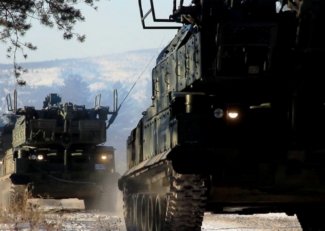Russian massacre in Volnovakha. Day 614 of the war

The situation in the combat zones has not fundamentally changed. The Russians consolidated their position on the north-eastern outskirts of the coke-chemical complex, the main bastion of Ukrainian resistance in Avdiivka, while the Ukrainians have done likewise in the western part of the village of Krynky on the left bank of the Dnieper (west of Nova Kakhovka). The various attacks and counter-attacks in the other operational directions in the areas of Kupyansk, Bakhmut (where Ukrainian forces made another attempt to break the Russian defences along the Bakhmut-Horlivka railway line), Velika Novosilka and Orikhiv also failed to bring about any significant results. According to the Ukrainian General Staff, the intensity of clashes has dropped from 60–70 per day (27–29 October) to 36 (30 October), and the Russians are probably most active in the area of Marinka, which they have been attacking between 15 and 20 times a day. On 30 October, spokesman for the Taurida Group of Forces Oleksandr Shtupun reported that the invaders had amassed 40,000 troops and 300 tanks in the area of Avdiivka. On the same day, the commander of the Ukrainian Land Forces, General Oleksandr Syrski, reported a significant reinforcement of the Russians’ forces around Bakhmut; he admitted that the Russians there had moved from defensive to offensive operations.
On 29 and 31 October, the area of Myrhorod in Poltava oblast was the target of Russian Ch-59 missiles (most likely a military airfield). On 30 October, three Russian Iskander-M ballistic missiles struck a repair yard in Odesa, resulting in the destruction or damage of its equipment, according to Ukrainian sources; four people were injured. On that day, an Iskander-M missile also hit Zaporizhzhia, destroying what was referred to as a ‘social infrastructure facility’. Two Kh-59 missiles were said to have been shot down over Dnipropetrovsk oblast, with shrapnel damaging several facilities. On 28 October, the Ukrainians reported that three out of four Iskander-K cruise missiles heading for the same area had been neutralised. According to communiqués from the General Staff, on 27–30 October the invaders used seven or eight missiles of different types each day. On 29–31 October, Russian Shahed-136/131 kamikaze drones unsuccessfully attacked Khmelnytskyi oblast, as they did in Mykolaiv oblast on 29 October. Five drones were used by the invaders on that day, twelve on the next day, and two on the day after that; according to the General Staff, all of them were shot down. On 31 October, a thermal power station in the Ukrainian-controlled part of Donetsk oblast was damaged as a result of Russian artillery shelling. The cities of Kherson and Nikopol are still under continual shelling and bombing.
On 30 October, Ukrainian forces carried out a combined attack on Crimea using various types of missiles and kamikaze drones. The Strategic Communications Department of the Ukrainian Armed Forces reported that a strategic air defence facility in the western part of the peninsula had been hit. According to later unofficial reports, one of the two ATACMS missiles used by the Ukrainians damaged an S-300 system launcher from a grouping located west of Yevpatoria. In addition, the defenders were said to have used eight Storm Shadow cruise missiles, two Neptun missiles and two surface drones, which according to Russian sources were destroyed before reaching their targets. On 29 October, the Russians reported that 36 Ukrainian drones had attacked Crimea; all of them were shot down or neutralised by means of electronic warfare. On the same day, Ukrainians attacked the Afip oil refinery in Krasnodar krai with kamikaze drones; a fire broke out there. Meanwhile on 28 October, Russian sources reported that six Ukrainian kamikaze drones were shot down over Oryol and Tula oblasts.
On 27 October, the head of the Joint Press Centre for Operational Command ‘South’, Nataliya Humeniuk, reported that the Black Sea Fleet’s hydrographic vessel Vladimir Kozitskiy was probably damaged by a Russian mine at the Sevastopol roadstead. Russian sources spoke of a possible Ukrainian attack using the Remus 100 submarine drone; this was allegedly proved by the device’s low explosive power and the fact that the small vessel (with a displacement of around 200 tonnes) was still able to carry out its tasks.
On 30 October, the TASS agency confirmed reports that the commander of the ‘Dniepr’ Army Group, General Oleg Makarevich, had been dismissed from his post; he had been responsible for the situation in the occupied part of Kherson oblast. His position has been taken by the former deputy of the Joint Group of Russian Forces in Ukraine, General Mikhail Teplinsky, who is also the commander of the Airborne Forces. According to unofficial Russian sources, this took place on 19 October.
On 27 October, the German Chancellery announced the transfer of another military support package to Ukraine. It includes IRIS-T SLM air defence system launchers with missiles and a TRML-4D radar, four armoured personnel carriers (type not indicated), four HX81 trucks with trailers, eight Vector reconnaissance drones, four GO 12 counter-battery radars, and M26 cluster munitions for HIMARS launchers. The package also included five small Sonobot 5 surface drones for surveying the bottoms of inland bodies of water. According to subsequent reports in the German media, a total of 15 such drones have already been delivered to Ukraine, and a further 55 will be sent. On 30 October, the German Air Force announced the start of training for 61 Ukrainian servicemen to operate the next Patriot system.
On 27 October, nine people (including two children and their parents) were shot dead in occupied Volnovakha (Donetsk oblast); the murders was carried out at night when the entire family was asleep. The crime was quickly reported on by Russian and Ukrainian social media, and sparked a wave of outrage on both sides of the frontline. The Investigative Committee of the Russian Federation then announced the opening of an investigation into the case, and on 30 October reported the arrest of the perpetrators, allegedly two Russian professional soldiers from the Far East.
On 27 October, Russian social media reported an assassination attempt on Oleh Tsaryov in the grounds of a sanatorium in Yalta; he was seriously injured and has been taken to hospital. According to Ukrainska Pravda, the assassination attempt was organised by the Security Service of Ukraine. Tsaryov was a deputy in the Ukrainian parliament; in 2014, he switched sides to Russia and took an active part in organising the occupation authorities in Donetsk and Lugansk oblasts, and in 2022 he supported the Russian invasion of Ukraine.
Also on 27 October, demonstrations were held in several Ukrainian cities (including Kyiv, Lviv, Ternopil, Khmelnytskyi, Dnipro, Zaporizhzhia, Kryvyi Rih and Odesa) by military families, who were demanding fair mobilisation, increased rotation in the fighting units and demobilisation after 18 months of wartime service. No anti-war or peace slogans were used. The demonstrations took place in a peaceful atmosphere and were mostly attended by no more than a few dozen people. The participants also drew attention to the Ukrainian president’s lack of response to a petition submitted two months ago which called for the introduction of the institution of health leave for mobilised soldiers who have spent 18 months on wartime service.
Commentary
- The massacre at Volnovakha is one of the most serious war crimes committed by Russian soldiers against civilians to have been confirmed by the investigative bodies of the Russian Federation. It is another manifestation of the collapse of discipline and the ongoing criminalisation of the Russian army. The main causes of these processes include the mass recruitment of prisoners (first to the Wagner Group and then, from the beginning of 2023, to the Storm-Z assault troops organised by the Russian Ministry of Defence) and the increasingly brutal methods used in regular army units. Increasingly, commanders are using violence, such as illegal imprisonments, torture or show shootings, to maintain discipline (recently, cases of execution of soldiers refusing to attack Ukrainian positions near Avdiivka were reported by US National Security Council spokesman John Kirby). There is also a trend towards more lenient sentences for Russian soldiers who have committed crimes in the rear; the courts are imposing suspended sentences or fines in such cases, so that the offender can be returned to the front.
- In Ukraine, the subject of soldier fatigue and the need to increase the rotation of fighting troops and extend mobilisation to younger age-groups (under 27) and residents of large cities, where it is easier to obtain exemption, is increasingly being discussed. The difficulties of manpower shortages, especially in infantry brigades, have already been mentioned in media interviews, even by company and battalion commanders. The problem is serious, and will require Ukraine’s military and political leadership to take unpopular decisions over the coming months, although as yet it has not become an openly public crisis. The soldiers’ families have so far rarely resorted to public protests, and these have not yet become any more popular. Nor has there so far been an escalation of violence in Ukraine against this background, along the lines of the anti-mobilisation protests which took place in the North Caucasus in September 2022.






